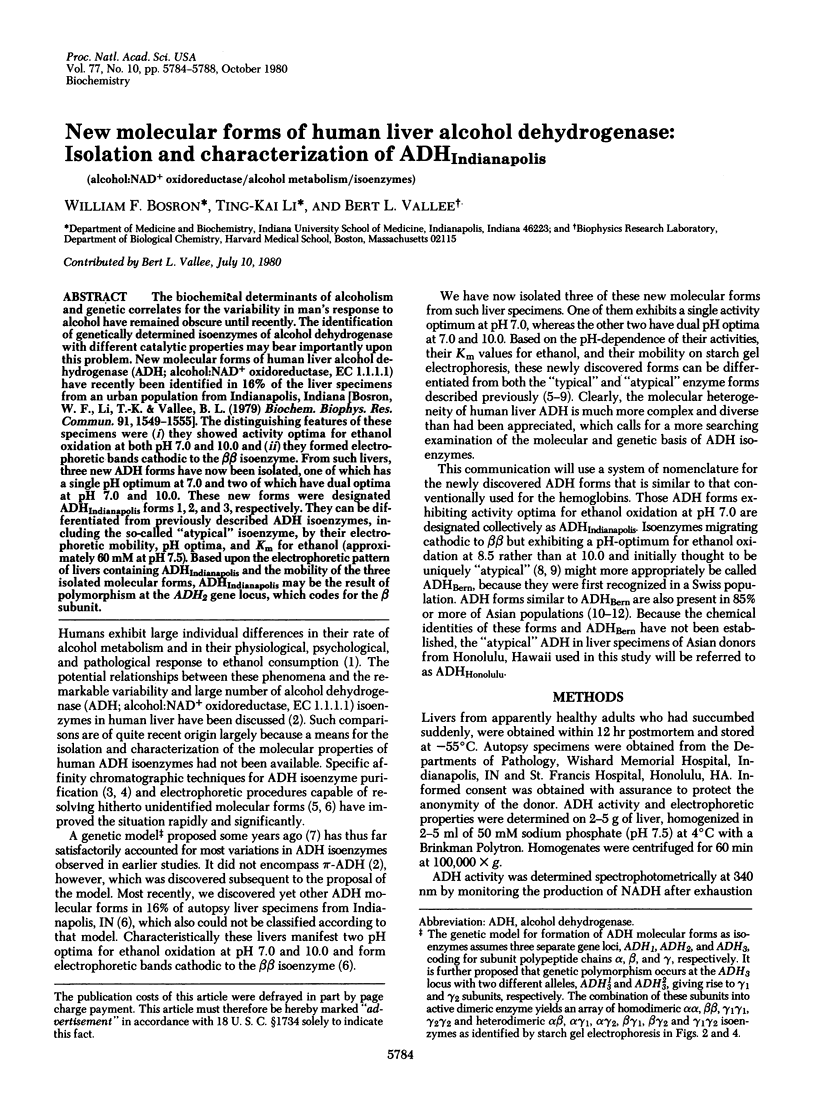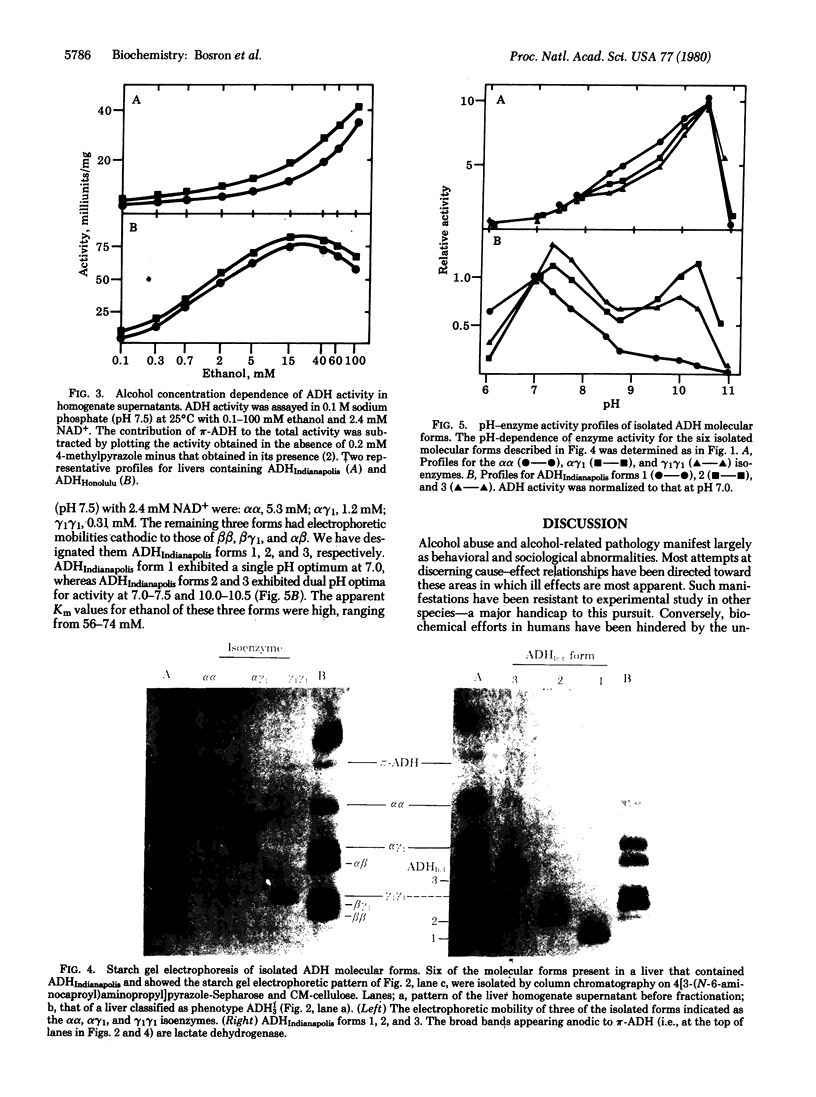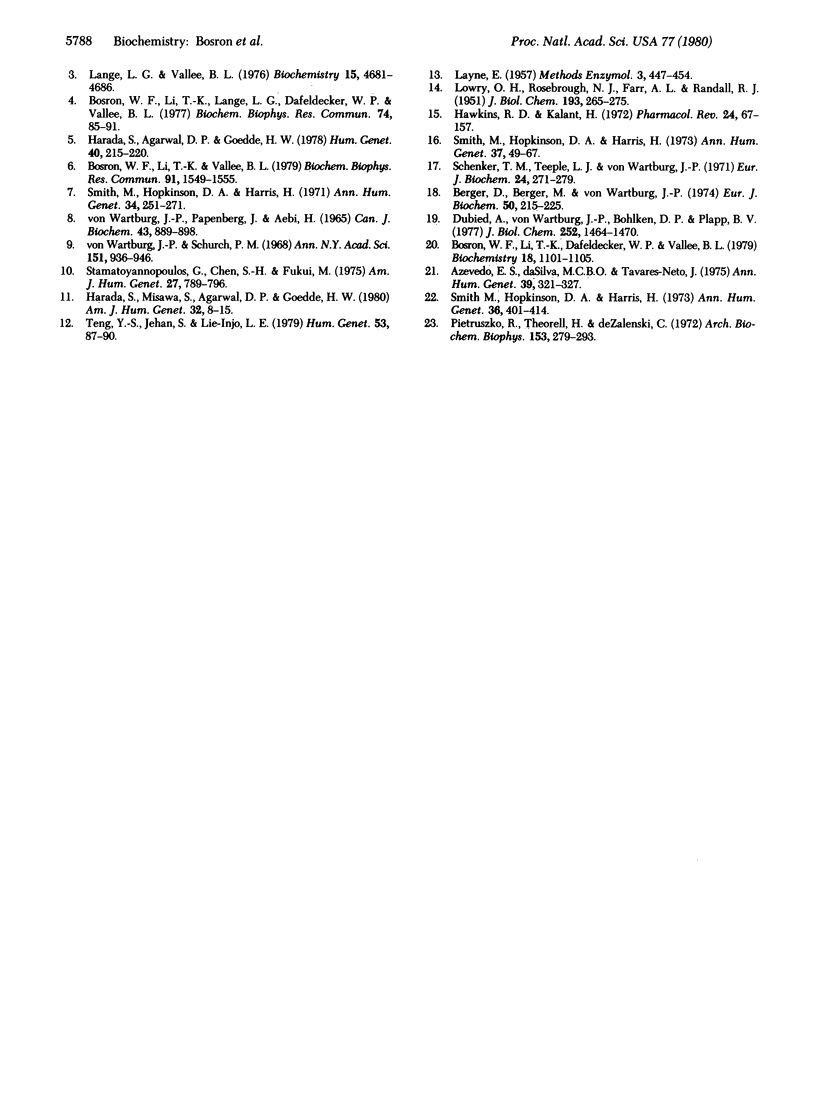Abstract
The biochemical determinants of alcoholism and genetic correlates for the variability in man's response to alcohol have remained obscure until recently. The identification of genetically determined isoenzymes of alcohol dehydrogenase with different catalytic properties may bear importantly upon this problem. New molecular forms of human liver alcohol dehydrogenase (ADH; alcohol:NAD+ oxidoreductase, EC 1.1.1.1) have recently been identified in 16% of the liver specimens from an urban population from Indianapolis, Indiana [Bosron, W. F., Li, T.-K. & Vallee, B. L. (1979) Biochem. Biophys. Res. Commun. 91, 1549-1555]. The distinguishing features of these specimens were (i) they showed activity optima for ethanol oxidation at both pH 7.0 and 10.0 and (ii) they formed electrophoretic bands cathodic to the beta beta isoenzyme. From such livers, three new ADH forms have now been isolated, one of which has a single pH optimum at 7.0 and two of which have dual optima at pH 7.0 and 10.0. These new forms were designated ADHIndianapolis forms 1,2, and 3, respectively. They can be differentiated from previously described ADH isoenzymes, including the so-called "atypical" isoenzyme, by their electrophoretic mobility, pH optima, and Km for ethanol (approximately 60 mM at pH 7.5). Based upon the electrophoretic pattern of livers containing ADHIndianapolis and the mobility of the three isolated molecular forms, ADHIndianapolis may be the result of polymorphism at the ADH2 gene locus, which codes for the beta subunit.
Full text
PDF




Images in this article
Selected References
These references are in PubMed. This may not be the complete list of references from this article.
- Azevedo E. S., Da Silva C. B., Tavares-Neto J. Human alcohol dehydrogenase ADH1, ADH2 and ADH3 loci in a mixed population of Bahia, Brazil. Ann Hum Genet. 1976 Jan;39(3):321–327. doi: 10.1111/j.1469-1809.1976.tb00136.x. [DOI] [PubMed] [Google Scholar]
- Berger D., Berger M., von Wartburg J. P. Structural studies of human-liver alcohol-dehydrogenase isoenzymes. Eur J Biochem. 1974 Dec 16;50(1):215–225. doi: 10.1111/j.1432-1033.1974.tb03890.x. [DOI] [PubMed] [Google Scholar]
- Borson W. F., Li T. K. Isolation and characterization of an anodic form of human liver alcohol dehydrogenase. Biochem Biophys Res Commun. 1977 Jan 10;74(1):85–91. doi: 10.1016/0006-291x(77)91378-x. [DOI] [PubMed] [Google Scholar]
- Bosron W. F., Li T. K., Dafeldecker W. P., Vallee B. L. Human liver pi-alcohol dehydrogenase: kinetic and molecular properties. Biochemistry. 1979 Mar 20;18(6):1101–1105. doi: 10.1021/bi00573a026. [DOI] [PubMed] [Google Scholar]
- Bosron W. F., Li T. K., Vallee B. L. Heterogeneity and new molecular forms of human liver alcohol dehydrogenase. Biochem Biophys Res Commun. 1979 Dec 28;91(4):1549–1555. doi: 10.1016/0006-291x(79)91241-5. [DOI] [PubMed] [Google Scholar]
- Dubied A., von Wartburg J. P., Bohlken D. P., Plapp B. V. Characterization and kinetics of native and chemically acitvated human liver alcohol dehydrogenases. J Biol Chem. 1977 Feb 25;252(4):1464–1470. [PubMed] [Google Scholar]
- Harada S., Agarwal D. P., Goedde H. W. Human liver alcohol dehydrogenase isoenzyme variations. Improved separation methods using prolonged high voltage starch-gel electrophoresis and isoelectric focusing. Hum Genet. 1978 Jan 19;40(2):215–220. doi: 10.1007/BF00272304. [DOI] [PubMed] [Google Scholar]
- Harada S., Misawa S., Agarwal D. P., Goedde H. W. Liver alcohol dehydrogenase and aldehyde dehydrogenase in the Japanese: isozyme variation and its possible role in alcohol intoxication. Am J Hum Genet. 1980 Jan;32(1):8–15. [PMC free article] [PubMed] [Google Scholar]
- LOWRY O. H., ROSEBROUGH N. J., FARR A. L., RANDALL R. J. Protein measurement with the Folin phenol reagent. J Biol Chem. 1951 Nov;193(1):265–275. [PubMed] [Google Scholar]
- Lange L. G., Vallee B. L. Double-ternary complex affinity chromatography: preparation of alcohol dehydrogenases. Biochemistry. 1976 Oct 19;15(21):4681–4686. doi: 10.1021/bi00666a022. [DOI] [PubMed] [Google Scholar]
- Li T. K., Bosron W. F., Dafeldecker W. P., Lange L. G., Vallee B. L. Isolation of pi-alcohol dehydrogenase of human liver: is it a determinant of alcoholism? Proc Natl Acad Sci U S A. 1977 Oct;74(10):4378–4381. doi: 10.1073/pnas.74.10.4378. [DOI] [PMC free article] [PubMed] [Google Scholar]
- Pietruszko R., Theorell H., De Zalenski C. Heterogeneity of alcohol dehydrogenase from human liver. Arch Biochem Biophys. 1972 Nov;153(1):279–293. doi: 10.1016/0003-9861(72)90446-8. [DOI] [PubMed] [Google Scholar]
- Schenker T. M., Teeple L. J., Von Wartburg J. P. Heterogeneity and polymorphism of human-liver alcohol dehydrogenase. Eur J Biochem. 1971 Dec;24(2):271–279. doi: 10.1111/j.1432-1033.1971.tb19681.x. [DOI] [PubMed] [Google Scholar]
- Smith M., Hopkinson D. A., Harris H. Developmental changes and polymorphism in human alcohol dehydrogenase. Ann Hum Genet. 1971 Feb;34(3):251–271. doi: 10.1111/j.1469-1809.1971.tb00238.x. [DOI] [PubMed] [Google Scholar]
- Smith M., Hopkinson D. A., Harris H. Studies on the properties of the human alcohol dehydrogenase isozymes determined by the different loci ADH1, ADH2, ADH3. Ann Hum Genet. 1973 Jul;37(1):49–67. doi: 10.1111/j.1469-1809.1973.tb01814.x. [DOI] [PubMed] [Google Scholar]
- Smith M., Hopkinson D. A., Harris H. Studies on the subunit structure and molecular size of the human alcohol dehydrogenase isozymes determined by the different loci, ADH1, ADH2, and ADH3. Ann Hum Genet. 1973 Apr;36(4):401–414. doi: 10.1111/j.1469-1809.1973.tb00604.x. [DOI] [PubMed] [Google Scholar]
- Stamatoyannopoulos G., Chen S. H., Fukui M. Liver alcohol dehydrogenase in Japanese: high population frequency of atypical form and its possible role in alcohol sensitivity. Am J Hum Genet. 1975 Nov;27(6):789–796. [PMC free article] [PubMed] [Google Scholar]
- Teng Y. S., Jehan S., Lie-Injo L. E. Human alcohol dehydrogenase ADH2 and ADH3 polymorphisms in ethnic Chinese and Indians of West Malaysia. Hum Genet. 1979;53(1):87–90. doi: 10.1007/BF00289455. [DOI] [PubMed] [Google Scholar]
- li T. K. Enzymology of human alcohol metabolism. Adv Enzymol Relat Areas Mol Biol. 1977;45:427–483. doi: 10.1002/9780470122907.ch6. [DOI] [PubMed] [Google Scholar]
- von Wartburg J. P., Papenberg J., Aebi H. An atypical human alcohol dehydrogenase. Can J Biochem. 1965 Jul;43(7):889–898. doi: 10.1139/o65-102. [DOI] [PubMed] [Google Scholar]
- von Wartburg J. P., Schürch P. M. Atypical human liver alcohol dehydrogenase. Ann N Y Acad Sci. 1968 Jul 31;151(2):936–946. doi: 10.1111/j.1749-6632.1968.tb48280.x. [DOI] [PubMed] [Google Scholar]




